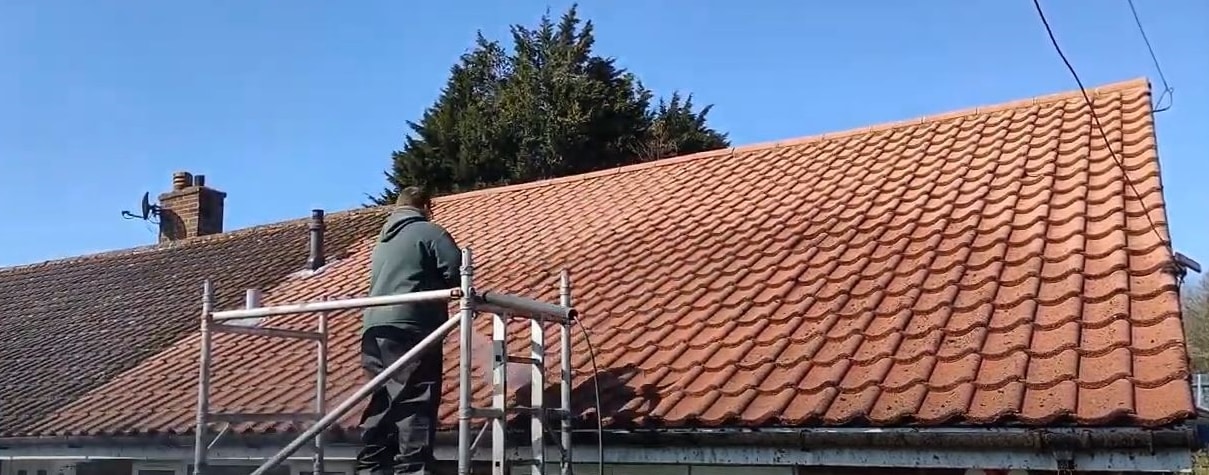Home Depot & Lowe’s: Do-It-Yourself Profits
8 min read
Miniature model house standing on a heap of dollar bills. Photo with clipping path.Some similar … [+]
getty
There are few industries in which just two companies hold such a dominant market share, but there are few consumers who have not shopped Home Depot (HD) or Lowe’s (LOW) for their home improvement, renovation or gardening needs. Here, four leading stock experts and contributors to MoneyShow.com review the bullish case for both stocks.
Christopher Graja, CFA, Argus Research
Lowe’s (LOW) is the world’s second-largest home improvement retailer, with sales of $96 billion in FY22. Based in Mooresville, North Carolina, the company operated 1,971 home improvement and hardware stores in the U.S., and Canada at the end of FY22.
Lowe’s recently reaffirmed its guidance for FY23 and announced that CFO David Denton was leaving the company. We believe that Mr. Denton’s departure is a significant loss for Lowe’s at a critical time. One of Mr. Denton’s greatest accomplishments is that he, along with CEO Ellison, helped Lowe’s to establish credibility as a company that could reverse many years of weak margins.
Lowe’s new CFO, Brandon Sink, must keep Lowe’s on the path of financial discipline and margin improvement, and establish credibility, as Mr. Denton did, for providing and exceeding credible financial guidance. Mr. Sink must also maintain Mr. Denton’s focus on communicating the company’s priorities for capital allocation and capital efficiency.
We believe that CEO Marvin Ellison is demonstrating the experience and ability to improve operations and raise profitability at Lowe’s. The company has upgraded its business analytics, upgraded its website, and streamlined its Canadian operations, which should lead to market share gains and better margin performance.
Mr. Ellison spent more than a decade improving customer service and efficiency at Home Depot. More recently, he served as CEO of J.C. Penney. We believe his experience in the very difficult department store business gives him a sense of urgency to constantly improve operations at Lowe’s and take nothing for granted.
Lowe’s delivered strong comparable sales and showed operating and financial discipline in FY21’s (calendar 2020) uncertain first half, which encompassed the first phase of the COVID-19 pandemic. The global health crisis has caused investors to differentiate between business models that are well positioned for the future and those that face significant challenges.
FILE – Shoppers walk in the lot of a Lowe’s home improvement store in Philadelphia, Wednesday, Nov. … [+]
ASSOCIATED PRESS
LOW’s strong performance continued into the second half of FY21 and FY22, supporting our view that the company is well positioned to deliver future earnings growth. We believe that the shares stand out for diversified investors who are looking for exposure to discretionary retail at financially strong companies.
We are maintaining our FY23 EPS estimate of $13.10. At the time of the 4Q22 earnings release in February, Lowe’s provided FY23 EPS guidance of $13.10-$13.60, up from its December forecast of $12.25-$13.00. We are reiterating our FY24 estimate of $14.50.
Lowe’s weathered the first phase of the COVID-19 cri- sis better than most retailers, as home repairs and building activity was treated as essential in most of the U.S. The company dramatically increased spending to protect and reward employees who are working in stores and warehouses.
LOW also restricted store hours, reduced promotions, suspended share repurchases, increased the capacity of short-term credit facilities, and borrowed $4 billion in the bond market. We believe that CEO Marvin Ellison will continue to succeed with his turnaround initiatives. The strong performance in 1H21 was potentially a turning point, and the FY22 performance was a strong confirmation, but he still has a lot of work to do.
Our bullish multiyear thesis is more dependent on business improvement than the macro environment. The company has expressed a commitment to raising the operating margin over a range of sales scenarios and gaining market share by improving merchandising and broadening its product offering.
We believe that the major drivers of post-pandemic sales growth remain the same. There has been significant underinvestment in housing. About 70% of U.S. homes are more than 25 years old and likely in need of upgrades and repairs. Millennials are starting families. Mr. Ellison said on the 1Q22 conference call that the company’s research findings show that the importance of the home will be elevated for many years to come.
Based on our analysis, the shares would be worth approximately $320 using a dividend discount model with our new earnings estimates. Our valuation for Lowe’s reflects our five-year growth rate of 14%, declining to 3% as the business and turnaround mature. Our cost of equity is 7.75%. We assume that the company can pay out about 80% of earnings when it is growing at 3%.
The shares have an indicated dividend yield of about 1.6%. The company has raised its dividend at a 17% annual rate over. We are maintaining our target price of $290. We have confidence in CEO Ellison’s turnaround plan and expect strong demand for home improvement products. We are reiterating our buy rating on Lowe’s and our target price of $290. With more than 40% of upside to our target, we are taking a gradualist approach to additional increases.
Bob Ciura, Top 10 Dividend Elite
Lowe’s is a Dividend King as it has raised its dividend for 59 years in a row, even during recessions and during the last financial crisis. Furthermore, its dividend payout ratio is only 24%. Lowe’s dividend is safe and likely has many years of strong growth ahead.
Lowe’s business is somewhat cyclical, but the company performed relatively well during the Great Recession. Despite the severe downturn of the housing market in the 2008 to 2009 recession, earnings-per-share declined by less than 20%. The company posted earnings-per-share of $1.49, $1.21, and $1.44 in the 2008 through 2010 period, while the dividend kept increasing.
Lowe’s is not opening many new stores right now, but the company has still managed to grow its earnings-per-share at an incredibly attractive pace in the past. This is due to several factors, including strong comparable store sales performance, which lifts revenue as well as margins. We are forecasting 6% annual growth over the intermediate term.
Lowe’s is presently trading at 15 times estimated earnings. We peg fair value at 20.5 times earnings, implying the potential for a 6.5% yearly improvement from the valuation. When combined with the 1.6% starting yield and 6% growth rate, this implies the potential for 14.1% in annual returns
Gordon Pape, Internet Wealth Builder
The rationale for Home Depot’s (HD) rise during the pandemic was simple. With all the restrictions on travel, social events, dining, etc., people had little on which to spend their money. Fixing up the house was among the few viable options, and do-it-yourself retailers thrived.
COLMA, CA – AUGUST 18: Home Depot workers move a pallet of bricks in front of a Home Depot store … [+]
Getty Images
Now that most restrictions have been lifted (even though the pandemic is by no means history), there are more spending options. Moreover, with interest rates rising, the cost of financing a major home renovation, perhaps through a home equity line of credit, is getting expensive. That’s a downer for the growth prospects of Home Depot and similar companies.
Home Depot is now a beaten-down stock. The company’s results for the fourth quarter and fiscal 2021 indicate the fall-off was starting to take hold by year-end. Moreover, guidance for 2022 was discouraging and the stock sold off. The forecast for sales growth in 2022 is that it will be “slightly positive”. That’s a big drop from 14.4% in 2021.
The company, however, is still very profitable. Net earnings for the fourth quarter were $3.4 billion ($3.21 per diluted share), compared with $2.9 billion ($2.65 per share) the year before. On a per share basis, that was up 21.1% year-over-year.
For the full year, net earnings were $16.4 billion ($15.53 per share), compared with $12.9 billion ($11.94 per share) in fiscal 2020. That was a 30.1% increase on a per share basis. The company projects 2022 earnings per share growth will be in the low single digits.
The gloomy outlook didn’t stop the board of directors from approving a 15% increase in the quarterly dividend, to $1.90 ($7.60 per year). The p/e ratio is reasonable, but not dirt cheap, at 19.33.
The company has a long history of gradually increasing shareholder value. Five years ago, you could have bought shares at about half the current price. Except for 2021, it has increased its dividend every year for the past decade.
I recommend Home Depot for patient investors. The stock offers long-term capital gains potential and in the interim, you will receive a respectable dividend that will likely continue to rise. Given the instability of the markets, I suggest buying a half position now. If the share price slips below $275, add to it. This company may be in for a rough period but that will pass, and the stock will flourish again.
Ben Reynolds, Passive Income Newsletter
Home Depot expects sales growth and comparable sales to be slightly positive following two blockbuster years of revenue gains, and flat operating margins. We forecast just over $16 in earnings-per-share for fiscal 2022.
Home Depot’s payout ratio is under half of earnings, which means we see the dividend as extremely safe, especially considering the company’s outstanding growth trajectory. The safety implied in such an arrangement also means that we expect Home Depot to have ample room to continue to raise the payout in the years to come.
The company’s recession resilience depends upon the type of recession experienced. For instance, in the real estate-driven Great Recession of 2008-2009, Home Depot should weather future recessions, and weakness in future recessions is almost certain to be temporary.
Its growth history is outstanding, averaging almost 18% annually in the past decade. Part of that has to do with a 3.4% average annual decline in the share count, which is something we expect will continue. But the company has also managed to boost its company-wide earnings very steadily, and at high rates.
We forecast 7% annual earnings-per-share growth in the years ahead, which we see as driven primarily by higher revenue. As Home Depot isn’t opening new stores in meaningful quantities, we believe higher comparable sales — attributable mostly to higher average ticket sizes — should continue to drive Home Depot’s revenue and earnings in the years ahead.






.jpg)